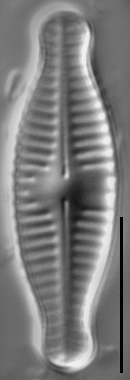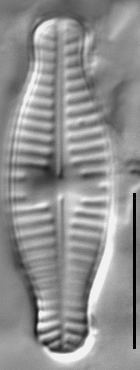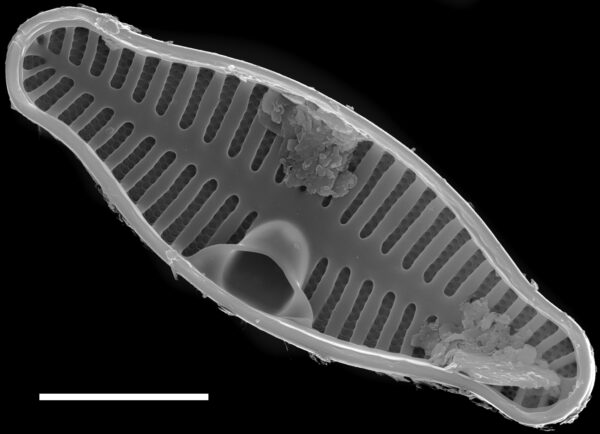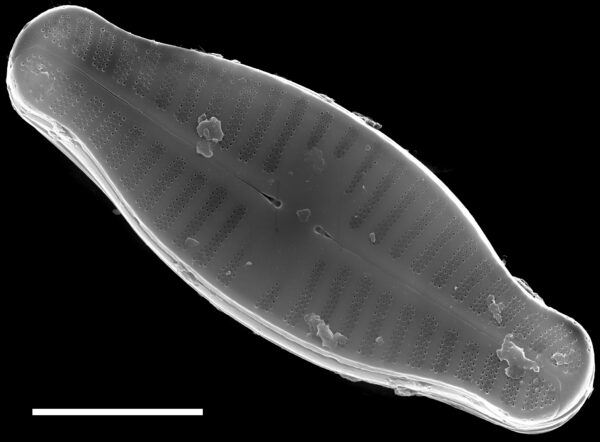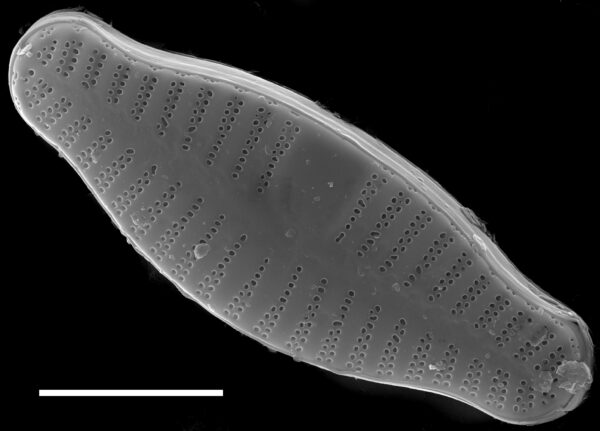Planothidium biporomum
-
Category
-
Length Range12-25 µm
-
Width Range5.4-7.0 µm
-
Striae in 10 µm12-15
-
ContributorMarina Potapova - Dec 2010
-
ReviewerSarah Spaulding - Aug 2013
Identification
View image metadata
Type
Description
Valves are lanceolate with capitate apices. The raphe valve has a linear axial area and a variable central area - from transversely rectangular to elliptic. The rapheless valve has a linear-lanceolate axial area and an asymmetric central area containing a cavum on the internal valve surface. The raphe is straight with expanded external proximal ends. Terminal raphe fissures are curved to the secondary side of the valve. The striae are multiseriate and radiate throughout both valves.
Autecology
This taxon was originally described from the Savannah River, Georgia (Hohn and Hellerman 1963). It was reported to occur in Ridley Creek, Pennsylvania and La Vase River, Canada (Patrick and Reimer 1966). The EPA western EMAP survey reported it in the western United States, in relatively clean waters across a range of elevation. It has favors sites with low riparian disturbance and minimal human impact.
Recent investigation shows that P. biporomum has a more restricted distribution than the widespread P. incuratum (Wetzel et al. 2013). These taxa have been confused in surveys of North America. Further work will clarify the records of each of these species.
-
Size Range, µm3
-
Motility
-
Attachment
-
Habitat
-
Colony
-
Occurrence
-
BCG
-
Waterbody
-
Distribution
- Learn more about this
Original Description
Valve lanceolate, ends subcapitate; length 20.8-22.8 μ, width 6.8-7.0 μ; striae straight, finely punctate, radiate throughout 14-16/10 μ; raphe valve: axial area narrow linear-lanceolate, central area moderate, transapically rectangular; raphe thin, sigmoid at terminal pores; rapheless valve: pseudoraphe narrowly linear lanceolate; unilateral horse-shoeshaped silaceous thickening superimposed on broad semicircular thickening. This taxon resembles several varieties of Achnanthes lanceolata (Bréb.) Grun. (K. sv. Vet-Akad. Handl. 17(2): 23, 1880) particularly A. lanceolata var. haynaldi (Saarsch.) Cl. (Diatomiste 2(17): 99, pl. 7, fig. 14, 1894). It differs in that the axial area of the raphe valve is distinctly lanceolate rather than linear and the terminal raphe pores are sigmoid, whereas in A. lanceolata var. haynaldii they are unilaterally bent. The rapheless valve differs from that of A. lanceolata var. haynaldii in that the pseudoraphe is lanceolate and the unilateral siliceous platform is composed of two overlapping areas of different thickness rather than a single platform.
-
BasionymAchnanthes biporoma
-
AuthorM.H.Hohn and Hellerman 1963
-
Length Range20-8-22.8 µm
-
Width6.8-7.0 µm
-
Striae in 10µm14-16
Citations & Links
Citations
-
Publication Link: 10.11646/phytotaxa.138.1.6
Links
-
North American Diatom Ecological DatabaseNADED ID: 155006
Updates
Feb 04, 2019 - Recognition of Planothidium incuriatum
From December 2010 until February 2019, the images presented under Planothidium bipororum contained three different forms. The first form has capitate apicies, as in the original description. The second form has subrostrate apices. This form was described as P. incuriatum (Wetzel et al. 2013). The third form is smaller, with slightly rostrate apices.
In February 2019, the images of specimens that conform to P. incuriatum and images of with slightly rostrate apices were removed. The "iconic images" and the "bird guide images" were replaced. An archived version of the original page is available upon request. - S. Spaulding
Cite This Page
Potapova, M. (2010). Planothidium biporomum. In Diatoms of North America. Retrieved April 18, 2024, from https://diatoms.org/species/planothidium_biporomum
Responses
The 15 response plots show an environmental variable (x axis) against the relative abundance (y axis) of Planothidium biporomum from all the stream reaches where it was present. Note that the relative abundance scale is the same on each plot. Explanation of each environmental variable and units are as follows:
ELEVATION = stream reach elevation (meters)
STRAHLER = distribution plot of the Strahler Stream Order
SLOPE = stream reach gradient (degrees)
W1_HALL = an index that is a measure of streamside (riparian) human activity that ranges from 0 - 10, with a value of 0 indicating of minimal disturbance to a value of 10 indicating severe disturbance.
PHSTVL = pH measured in a sealed syringe sample (pH units)
log_COND = log concentration of specific conductivity (µS/cm)
log_PTL = log concentration of total phosphorus (µg/L)
log_NO3 = log concentration of nitrate (µeq/L)
log_DOC = log concentration of dissolved organic carbon (mg/L)
log_SIO2 = log concentration of silicon (mg/L)
log_NA = log concentration of sodium (µeq/L)
log_HCO3 = log concentration of the bicarbonate ion (µeq/L)
EMBED = percent of the stream substrate that is embedded by sand and fine sediment
log_TURBIDITY = log of turbidity, a measure of cloudiness of water, in nephelometric turbidity units (NTU).
DISTOT = an index of total human disturbance in the watershed that ranges from 1 - 100, with a value of 0 indicating of minimal disturbance to a value of 100 indicating severe disturbance.
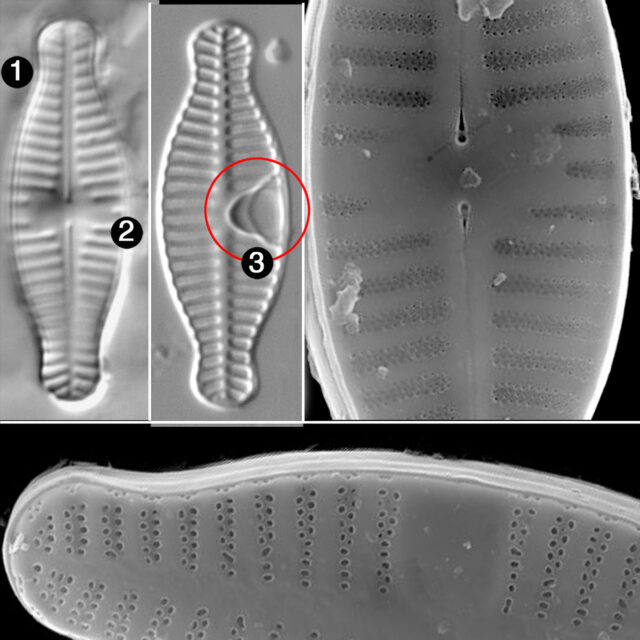
Planothidium biporomum
- Valves lanceolate with capitate apices
- Valves 5.4-7.0 μm wide
- Rapheless valve with a cavum
Valves are lanceolate with capitate apices, 12-25 μm long, 5.4-7.0 μm wide. The rapheless valve has a linear-lanceolate axial area and an asymmetric central area containing a cavum on the internal valve surface. The striae are multiseriate and radiate throughout both valves, 12-15 in 10 μm.
 Diatoms of North America
Diatoms of North America